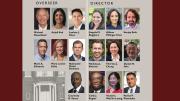Consider this little known fact: academic institutions hold more gene patents than the top 25 pharmaceutical companies and all biotech companies combined. A slide illustrating this revelation (see below) kicked off "Commercializing the Genome," held April 5 at the Harvard Business School, one in a series of University-wide, student-sponsored panels that examined the Human Genome Project from a variety of disciplinary perspectives.
Academic institutions have been licensing their gene patents to industry ever since the 1980 implementation of the Bayh-Dole Act, which gave small businesses--and, as an afterthought, universities--the right to patent gene discoveries derived from federally funded research. Are universities in it for the money? "On the whole, [they are] not," said panelist Lita Nelsen, director of MIT's technology licensing office. "A few hit the lottery, but for most, [licensing revenue] amounts to 1 or 2 percent of their research budget."
"The model for technology transfer from universities," she explained, "particularly in the medical area, is that...industry is far more likely to bring science from the laboratory...when there are economic incentives for companies to [risk investing] $300 million in something with a four out of five chance of failure." Indeed, panelist Maykin Ho, a managing director of Goldman Sachs, advised aspiring businesspeople in the audience that the process of bringing a product to market--including research, development, and testing in general populations--can be expected to take five to seven years, with another six months to two years to obtain Food and Drug Administration approval. Nelsen said industry won't turn laboratory discoveries into marketable products--despite potential medical benefits for everyone--unless the original investments of time and money can be protected with patents.
Universities have a wholly different mission: to disseminate new knowledge, not control it. "One of the things universities have said [they] will not do," says Nelsen, "is withhold information; [they] will publish everything" so that scientists, academic institutions, and other nonprofits will have "unfettered access and will not be locked out by these patents."
As a society looking for new medical breakthroughs, "We're in a hurry," said Nelsen. "Having change happen by putting discoveries in the literature and waiting for large companies to [find and market them] is just too slow." Thus the coupling of commerce to academic discovery has come to be seen as "a good thing--a public mission that accelerates the delivery of healthcare, rather than a dirty little secret."
The panel's venture capitalist, James Tullis, M.B.A. '72, CEO of Tullis-Dickerson and Co. Inc., said his firm is aggressively invested in collaborations between academia and the commercial world, but also in what he called "the converging space between the life sciences and technology." In this, he echoed the comments of Steven Holtzman, chief business officer of Millennium Pharmaceuticals, who argued that having the human-genome map is a revolution equivalent to knowing the periodic table of elements. "It's the periodic table of life," Holtzman said, signaling "not the end of biology, but the beginning." The process of drug discovery will change from an art analogous to alchemy to a science of pharmaceutical development that is more like chemistry, he predicted. Facilitating this revolution are "parallel revolutions in technology," specifically in robotics and the advanced information sciences, that allow researchers to gather and process the enormous amounts of molecular data that form the foundation of genomics-based medicine.
Discussion of a hypothetical case study involving a woman with a family history of breast cancer corrected a number of common misconceptions about the role that gene-based medicine will someday play in all our lives. Holtzman took pains to distinguish between the current popular notion of genetic disease--that it is monogenic (caused by a single gene) and highly penetrant (it shows up no matter what the environmental conditions)--and the reality: "Cancer and most of the major common diseases are polygenic; they involve multiple-gene contributions and are multifactorial," meaning many environmental factors affect whether or not these diseases show up. "The genetic disease that everyone thinks about is actually the limiting case" when genes alone are responsible, said Holtzman. Knowing your genetic makeup is not all that different from knowing your family history or being told that you have a high cholesterol level. A cholesterol level of 240 "doesn't mean you're going to die tomorrow," Holtzman pointed out, "even if you keep eating potato chips." The outcomes are probabilistic, and much of medical genetics will be the same way.
Public concerns about how such information will be used, and ethical questions surrounding issues such as the destruction of embryos or the practice of human cloning, mean that universities and the biopharmaceutical industry have a significant role to play in airing these issues. Holtzman, who has served since 1996 on the National Bioethics Advisory Commission, said that his company has always believed that public misunderstanding of the technology was the biggest threat it faced.
He likens the current debate over cloning to the better-known debate over gene therapy in the 1980s. Many people can now distinguish between somatic gene therapy--which will not be passed on to the next generation--and germline gene therapy. Once the public makes that distinction and realizes that its fears and concerns about genetic engineering exist only in the case of germline therapy, then informed social discourse about problems with somatic-gene therapy is possible. Today, people in molecular biology are making distinctions between therapeutic cloning (of brain cells to treat Parkinson's disease, for example, or perhaps of whole organs), and reproductive cloning, in which an entire individual can be cloned. These are "genuine public-policy concerns," said Holtzman, and industry can play a role in making sure that "we have a granular enough discourse to be able to make these distinctions."





